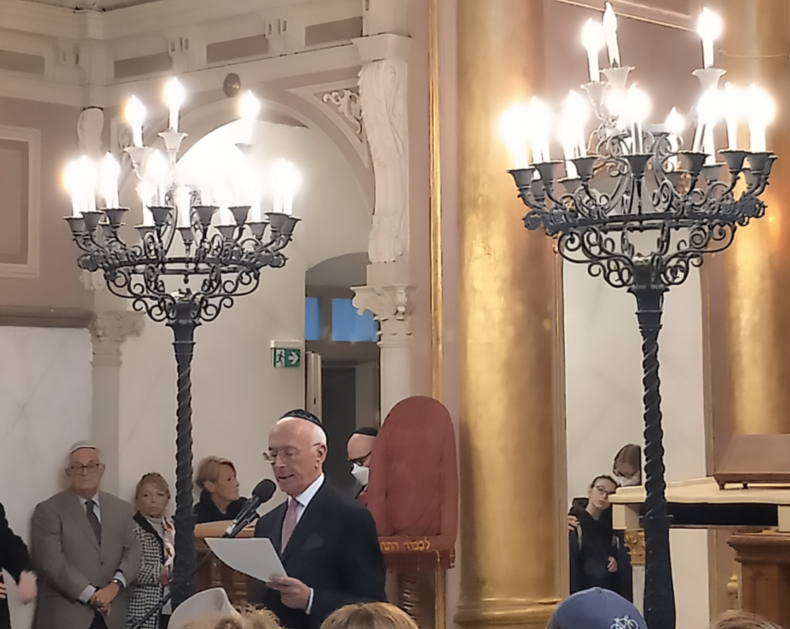“Synagogue reopening, an event for the whole country”

By Dario Disegni*
After an intense and meticulous redevelopment work, started following the flood of 1994 and made possible by the generous allocation granted by the Italian State from the funds of 8×1000, the Synagogue of Alessandria, characterized by its imposing façade of eclectic architecture with neo-Gothic influences, finally reopens. This is a significant event for the city, for Italian Judaism, and for the whole country.
One of the most beautiful Synagogues in Piedmont, it was festively inaugurated in 1871 after the Emancipation by king Charles Albert (king of Sardinia-Piedmont) was granted in 1848. The Synagogue encourages us to remember and think about the history of what was an important Community, present in the city, with various events, since the end of the fifteenth century, and which was tragically decimated in the Shoah, during which 25 of the 245 members inscribed in 1938 perished. Unfortunately, today the community is comprised of only a few units, although they are deeply rooted in their cultural and religious identity. In such an important day, I would like to briefly retrace some of the essential moments of the history of the Jews of Alessandria.
Abramo Vitale de Sacerdoti is one of the first Jewish people whose name appears on official documents. In 1490 he was allowed to reside in the city to run a loan-bank there. During the following centuries, his family played a leading role both within the Community and in the city, that at the time was under the Duchy of Milan. His descendant Simone was the one who prevented the implementation of the repeated orders of expulsion from the Spanish domains of Lombardy, that culminated in the expulsion of 1597.
When in 1707 the city came under Savoy rule, the affairs of the Jewish Community became linked to those of other territories of Piedmont. They maintained the freedom of residence, worship and commerce, but in 1723 they were segregated into a ghetto that was established between the present-day streets of Via Migliara, Via dei Martiri, Via Vochieri and Via Milano (at the time called “Contrada degli Ebrei”, literally “Jewish District”), an area where the Jewish population had long owned houses and shops.
The ghetto of Alessandria was the third most populous in Piedmont, with 420 inhabitants, as shown in the 1761 census. Despite the changes made in the 19th century, some characteristic features are still preserved, such as the internal communicating walkways and the mezzanines that were built in order to expand the surface of the houses in the years of forced residence.
After the emancipation of 1848, many Jews of Alessandria contributed in different ways to the life of the city and to the Italian Risorgimento. In the last century, the phenomenon of urbanization, along with racial persecution, led to a drastic reduction of the Community, until in 1985 it was forced to give up its autonomy in order to become a part of the Jewish Community of Turin.
During the Second World War, the Community and its Synagogue were terribly devastated.
In a letter sent in 1947 to the revenue office, with a request for compensation for the damages suffered, the then President of the Community Anselmo Vitale denounced: “On the evening of December 13th 1943, around 7 pm, armed forces of the fascist republican army and German soldiers broke into the premises of the Temple, the school and the administration of the Israeli Community of Alessandria, located in Via Milano 3, demolishing, removing, destroying and burning everything, from sacred furnishings to equipment, from works of art to silverware. […] In this condition, it is no longer possible to exercise, even partially, any form of worship, to provide school teaching and to carry out the administration of the Community and of the 10 charitable organizations it operates”.
It was an extremely painful wound, which after the war forced the Community to a patient reconstruction by using sacred furnishings from other dismantled Synagogues, such as those of Nizza Monferrato and Acqui Terme, to replace those that had been destroyed.
The subsequent increasing degradation, intensified by the damage caused by the flood of 1994, encouraged the Community of Turin, which following the merging with that of Alessandria became the owner of the Synagogue, to promote redevelopment works. They were able to make great progress in the redevelopment process thanks to the significant contribution allocated by the Italian State in 2018 from the funds of 8×1000.
One of the most important and prestigious historical buildings of the City, today the Synagogue of Alessandria thus appears to have returned to its original splendour, and it has been given back to the use of the Jewish Community, the citizens of Alessandria, and all the visitors who will be able to come visit it from Italy and from abroad.
*President of the Jewish Community of Turin
Translated by Annadora Zuanel, revised by Martina Bandini, students at the Secondary School of Modern Languages for Interpreters and Translators of the University of Trieste, interns at the newspaper office of the Union of the Italian Jewish Communities – Pagine Ebraiche.
